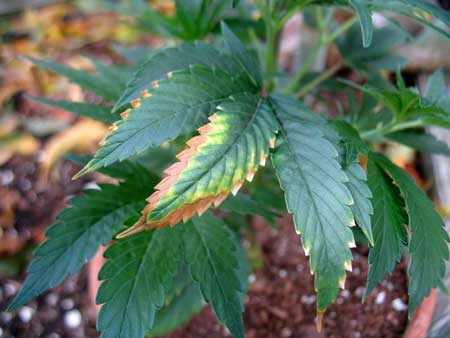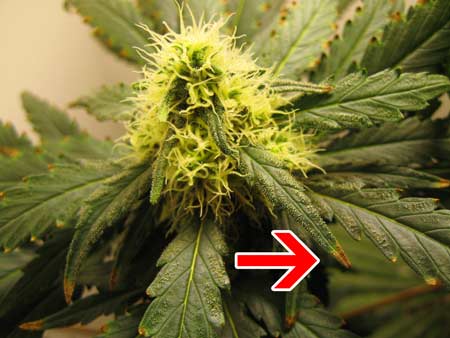how to fix nutrient burn
Nutrient burn is more often than not something every grower has dealt with at one time. Your plants like to eat, sometimes they eat more then they need so when your feed solution has a very high E.C, or PPMS, you will see this very common reaction on your plants. There are benefits to a high feed when your plants are established enough or when you have a regimented feeding schedule to negate nutrient antagonism and insoluble reactions while kept in solution. For example when making a feeding schedule if you are concerned with possible antagonism or insoluble reaction in high feed you can stagger your feeds to reduce unwanted reactions, feeding majors one day, minors adding later or as booster feeds.
"Just the Tip" Nutrient Burn
As seen in the photo at the top of the page, the yellowing/browning or burning seen at the tip is a clear sign of a high feed. This is ok as it lets the grower know that these are the limits of feeding at this time. We suggest you begin to dilute 10% of the feed at a time until you don't see the 'tip burn'.

Nutrient burn from high feed solution.
Another source of nutrient burn is from "Hot Soil" which is a term for soil that has high quantities of readily available nutrients that will cause nutrient burn. Mostly from the amendments in your soil, fresh compost, manure, bat guano, seed bird droppings.

The damage seen here in the photo above, is very similar to what you might see in a high feed nutrient burn.
Below is an example of a potassium deficiencies not to be confused with nutrient burn.

And this damage below also looking similar to nutrient burn but it's a Magnesium deficencies.

Also not to be confused with nutrient burn are pH fluctuations.

Understanding why nutrient burn is happening is as important as understanding the role your nutrients play in photosynthesis and plant health and the quality of product.
Cannabis as a plant is considered a weed, will almost grow anywhere and under extreme forms of stress. But when supplied with proper proportions of nutrients light and environment it's takes on different effects, higher yield with a higher concentration of cannabinoids and terpenes.
The technical term for applying nutrients to a media is fertigation but to differentiate between the process we use laymen terms like watering, feeding but we are never directly feeding the plant. Plants are biological machines absorbing nutrient rich solution at the root level to create sugars through photosynthesis that sustain the plant as it grows.
Specialized root hairs in the soil that absorb water and available nutrients referred to as a solution. Through a process called osmosis/capillary action your roots absorb this solution and sometimes exchanging nothing when and sometime releasing a hydrogen ion into your soil thus affecting pH.

Nutrient burn in early stages of life is generally not considered to be a huge issue, as long as it is taken care of when discovered.
As your plants enter their flowering stage of life, they will basically be on a countdown so while you want to feed as much as they will take often showing initial signs of nutrient burn. Care must be taken to not over do it.
We often hear more food more yields, and while it has a small amount of truth really it's the wrong way to think about it. While flowering the nutritional needs of your plants will change as it stretches and grows flowers that ripen into buds that in turn grow and harden. The casual relationship between feeding and yield exist but its more about frequency of feeds then actual amount of nutrients in your feed.
You can feed the same amount of nutrients by volume easier over time then a lot all at once and your plants prefer it this way as well. In the environment these plants evolved in, nutrients were readily available and only at times of heavy saturation was their more then enough or heavy droughts were their too little.

When correcting a nutrient burn issue, first thing is to rule out is other issues like pH or bad drainage or improper nutrient solutions. Test your run off pH and test your soil pH with a slurry test to gauge pH issues. If problems persist with pH its time to flush or leachate your media and start over with a balanced medium strength nutrient solution.
- Your media should have a pH of 5-5-6.7
- Your run off should be similar to your soil and or solution pH if its not you need to apply less nutrients but same amount of water
Read your suggested mixing rates of products you use to make sure they are correct. If you have changed any values be certain to apply that change proportionally. This can get confusing but within any nutrient line be it, bottle, dry salts, organics you will have a base that consist of the majors, trace elements and minors. In organic feeds often these will be different as in organics your amended soil is where your nutrients are derived from and feeds/waterings are often amendments w/humics/fulvics. This base consists of a set amount of nutrients that need to remain in proportion. These proportion can be changed but often require further amendments later to fill in the gaps missing.
Make sure your environment is good and plants are not experiencing to much air movement with temps(65-80 degrees) and humidity (30-60% preferably stable throughout day/night cyle) at optimal levels.
Make sure your media is healthy, not to wet not to dry, does not smell like decomposition with roots that are healthy and visible roots. Another rule of thumb when gauging amount to feed is a plant with less roots will require less feed/water.
At this point we have ruled out other possible issues or sources we can start to correct your nutrient burn. It is very simple you just dilute your mix once in solution, adding 10% more water each time till your plants are healthy and no longer experiencing burn. This done over time will have the effect of limiting further nutrient burn as well as any possible toxicity. Having an EC meter is nice at this point to measure what they want and at what stage of life this will help you determine a feeding schedule that works for you.
Correcting burn or at least limiting its effects are important as it will almost always lead to other problems over time. And while your plants are blooming your ability to correct becomes harder and harder as the plant growth timelines are not meet.
how to fix nutrient burn
Source: https://growingexposed.com/cannabis-doctor/nutrient-burn/
Posted by: mayaccatty.blogspot.com

0 Response to "how to fix nutrient burn"
Post a Comment